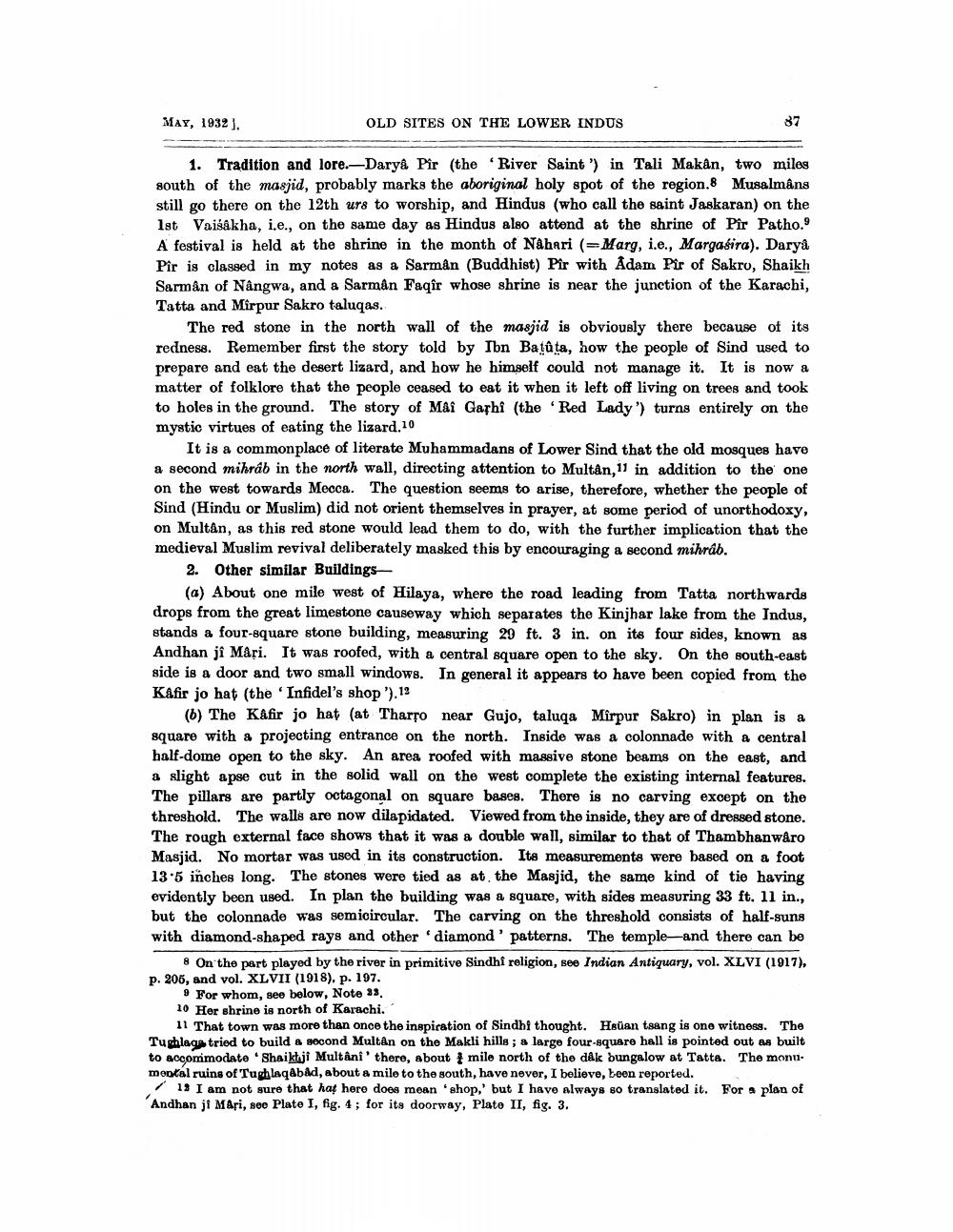________________
MAY, 1932.
OLD SITES ON THE LOWER INDUS
-
1. Tradition and lore.—Darya Pir (the River Saint ') in Tali Makan, two miles south of the masjid, probably marks the aboriginal holy spot of the region.8 Musalmans still go there on the 12th urs to worship, and Hindus (who call the saint Jaskaran) on the 1st Vaisakha, i.e., on the same day as Hindus also attend at the shrine of Pir Patho.9 A festival is held at the shrine in the month of Nahari (Marg, i.e., Margasira). Darya Pir is classed in my notes as a Sarman (Buddhist) Pir with Adam Pir of Sakro, Shaikh Sarman of Nângwa, and a Sarman Faqir whose shrine is near the junction of the Karachi, Tatta and Mirpur Sakro taluqas.
The red stone in the north wall of the masjid is obviously there because of its redness. Remember first the story told by Ibn Batuta, how the people of Sind used to prepare and eat the desert lizard, and how he himself could not manage it. It is now a matter of folklore that the people ceased to eat it when it left off living on trees and took to holes in the ground. The story of Mai Gashi (the Red Lady') turns entirely on the mystic virtues of eating the lizard.10
It is a commonplace of literate Muhammadans of Lower Sind that the old mosques have a second mihrab in the north wall, directing attention to Multán, 11 in addition to the one on the west towards Mecca. The question seems to arise, therefore, whether the people of Sind (Hindu or Muslim) did not orient themselves in prayer, at some period of unorthodoxy, on Multân, as this red stone would lead them to do, with the further implication that the medieval Muslim revival deliberately masked this by encouraging a second mihráb.
2. Other similar Buildings
(a) About one mile west of Hilaya, where the road leading from Tatta northwards drops from the great limestone causeway which separates the Kinjhar lake from the Indus, stands a four-square stone building, measuring 29 ft. 3 in. on its four sides, known as Andhan ji Mari. It was roofed, with a central square open to the sky. On the south-east side is a door and two small windows. In general it appears to have been copied from the Kafir jo hat (the 'Infidel's shop').12
(6) The Kâfir jo hat (at Tharso near Gujo, taluqa Mirpur Sakro) in plan is a square with a projecting entrance on the north. Inside was a colonnade with a central half-dome open to the sky. An area roofed with massive stone beams on the east, and & slight apse cut in the solid wall on the west complete the existing internal features. The pillars are partly octagonal on square bases. There is no carving except on the threshold. The walls are now dilapidated. Viewed from the inside, they are of dressed stone. The rough external face shows that it was a double wall, similar to that of Thambhanwaro Masjid. No mortar was used in its construction. Its measurements were based on a foot 13.5 inches long. The stones were tied as at the Masjid, the same kind of tie having evidently been used. In plan the building was a square, with sides measuring 33 ft. 11 in., but the colonnade was semicircular. The carving on the threshold consists of half-suns with diamond-shaped rays and other diamond' patterns. The temple and there can be
8 On the part played by the river in primitive Sindhi religion, see Indian Antiquary, vol. XLVI (1917), p. 206, and vol. XLVII (1918). p. 197.
9 For whom, see below, Note 39. 20 Her shrine is north of Karachi.
11 That town was more than once the inspiration of Sindhi thought. Heüan tsang is one witness. The Tuchlaan tried to build a second MultAn on the Makli hills; a large four-square hall is pointed out as built to accommodate 'Shaikhji Multâni' there, about #mile north of the dak bungalow at Tatta. The monumental ruins of Tugh laqabad, about a mile to the south, have never, I believe, been reported.
13 I am not sure that hať horo docs mean 'shop,' but I have always so translated it. For a plan of Andhan ji Mari, soe Plate I, fig. 4 ; for its doorway, Plato II, fig. 3.




